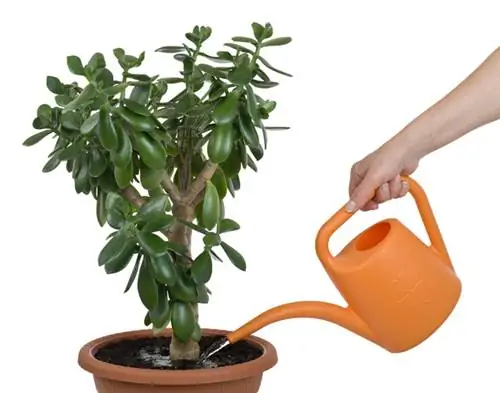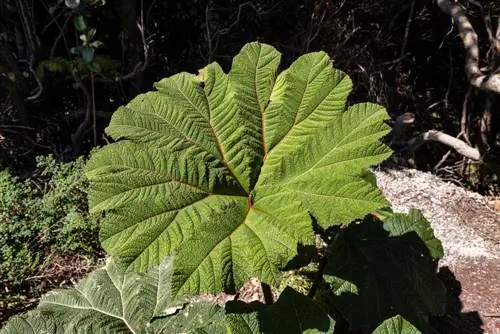- Author admin [email protected].
- Public 2023-12-16 16:46.
- Last modified 2025-01-23 11:22.
The decorative mammoth leaf (bot. Gunnera) cannot be described as absolutely easy to care for, but it is not too demanding either. Above all, it needs plenty of water and nutrients, then it usually thrives very well.

How do I properly care for a mammoth leaf?
The mammoth leaf requires a partially shaded location, moist but not wet soil, regular watering until autumn and slightly acidic fertilizer from April to June. Moderate frost protection is required in winter; Potted plants should overwinter frost-free.
Location and soil
In its Brazilian homeland, the mammoth leaf likes to grow along a stony stream or in a swamp. Moisture is essential, after all, evaporation is very high thanks to the oversized leaves. You can plant the rhubarb-like plant at the edge of your garden pond, but please not directly into the water.
Too much water damages the sensitive roots of the mammoth leaf, just as the blazing sun causes its leaves to burn. A location in light shade with humus-rich, preferably slightly acidic soil is therefore ideal.
Watering and fertilizing
The water requirement of the mammoth leaf is particularly high, especially in the first few weeks after planting and in the spring after budding. In the fall, however, you can reduce the watering. Between April and June, regularly add a little slightly acidic fertilizer (€8.00 on Amazon) to the irrigation water. Alternatively, you can also work some oak leaves into the soil.
The mammoth leaf in the bucket
The mammoth leaf can also be cultivated in a bucket, but then requires a relatively high amount of care. The roots must never be wet, so good drainage is required. Nevertheless, the mammoth leaf in the bucket needs a lot of water. Watering should be frequent and not too sparse, but always in such a way that excess water can drain off easily.
The mammoth leaf in winter
The mammoth leaf is considered to be conditionally hardy, meaning it can tolerate moderate frost up to a maximum of -10 °C. You can quickly winterize it with a thick layer of leaves or brushwood. When cultivating in a bucket, frost-free wintering is recommended.
The most important things in brief:
- only conditionally hardy
- prefers a partially shaded location and moist but not wet soil
- can be cultivated in a pot
- needs a lot of water until autumn, but cannot tolerate waterlogging
- fertilize regularly from April to June
- use slightly acidic fertilizer or oak leaves
- Overwinter potted plant frost-free
Tip
In the ideal location, the mammoth leaf does not need much more than sufficient water.






